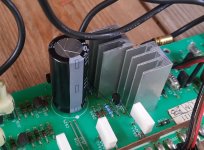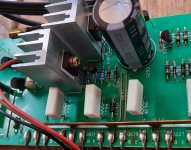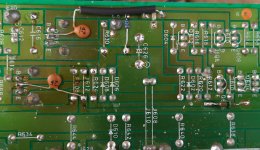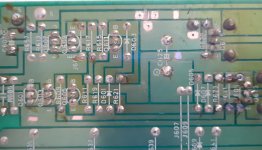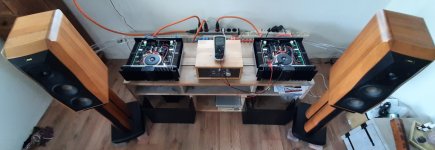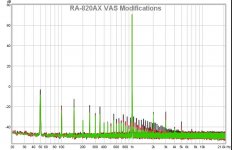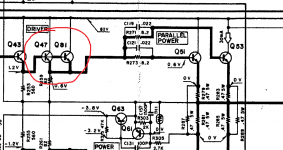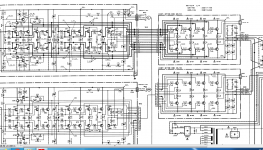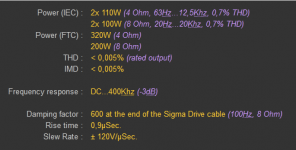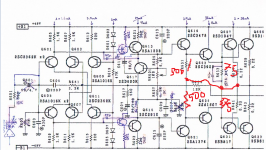If you used Cordell's scheme you'd have to redo your current mirror load pcbs with the addition of an extra transistor and two resistors. You might be able to use the same vas circuit subject to dissipation constraints.
@ Joe: since my last post, found this schematic link and downloaded/printed a few Rotel amps. The link below will take you to the one you’d like: RB985!
https://www.vintageshifi.com/repertoire-pdf/pdf/telecharge.php?pdf=Rotel-RB-985-Service-Manual.pdf
Hope this helps. Looking forward to my own tinkering after i complete a ginormous home improvement project that includes a pool.
Tony
https://www.vintageshifi.com/repertoire-pdf/pdf/telecharge.php?pdf=Rotel-RB-985-Service-Manual.pdf
Hope this helps. Looking forward to my own tinkering after i complete a ginormous home improvement project that includes a pool.
Tony
@Per: I have send you PM
@gp4Jesus: thx, I have the service manual already, that's why I know the RB985 is special. Unfortunately the schematic is drawn in a quite un-convenient way with the "outsourced" bias transistor and on two pages. Need to print it and merge it on paper and redraw some lines with colour not to get confused.
I think it is a nice amp, am really looking forward to fix it some day...Need to convert my attic first.
@gp4Jesus: thx, I have the service manual already, that's why I know the RB985 is special. Unfortunately the schematic is drawn in a quite un-convenient way with the "outsourced" bias transistor and on two pages. Need to print it and merge it on paper and redraw some lines with colour not to get confused.
I think it is a nice amp, am really looking forward to fix it some day...Need to convert my attic first.
Last edited:
@Joe et al. In case you missed it my RB985 tri-amps my center channel - it ain’t broke thankfully. I think your biggest challenge is 5 channels crammed into the “real estate” normally allowed for 2. BTW did you check the fuses? Tough to change.
My primary interest is simple SQ upgrades for it and several* other 900 series Rotel power amps. I so hope this pans out for ya.
* 6 in all - 2 980BXs & 4 981s
Right now I’m up to my eyeballs in a ginormous home improvement project that is centered around a pool.
Tony
My primary interest is simple SQ upgrades for it and several* other 900 series Rotel power amps. I so hope this pans out for ya.
* 6 in all - 2 980BXs & 4 981s
Right now I’m up to my eyeballs in a ginormous home improvement project that is centered around a pool.
Tony
Last edited:
RB-991 update
Hi there,
Just an update on how stoked i am with my overhauled amps.
The new psu caps and homebrew rectifier and some thicker copper wire gave it back its deep breath.
The changing of caps in every channel with the help of my good friend Doede gave me a more relaxed and more delicate sound.
But the cherry on the cake came when Per took a closer look and guided me in small steps through the stressed out VAS, wow.
The small steps gained before became leaps, seriously 😀
You can almost hear the pleasure when both Rotels stretch their legs and recreate the sound it is being fed single ended....
They're much more spacious, almost 3D, give more detail in the highs without giving tired ears, voices are dead center and sound crisp and natural, the deep bass is still there but without restrain and with ease. The fat and chunky bass is no more but i do not miss it at all.
My old amps, for me, sound way better then before and parts for the final VAS "upgrade" are, as we speak, crossing the North sea.
For me it will be a challenge to install but i'm looking forward to the job.
Cheers, Paulus
Stay safe and healthy!
Hi there,
Just an update on how stoked i am with my overhauled amps.
The new psu caps and homebrew rectifier and some thicker copper wire gave it back its deep breath.
The changing of caps in every channel with the help of my good friend Doede gave me a more relaxed and more delicate sound.
But the cherry on the cake came when Per took a closer look and guided me in small steps through the stressed out VAS, wow.
The small steps gained before became leaps, seriously 😀
You can almost hear the pleasure when both Rotels stretch their legs and recreate the sound it is being fed single ended....
They're much more spacious, almost 3D, give more detail in the highs without giving tired ears, voices are dead center and sound crisp and natural, the deep bass is still there but without restrain and with ease. The fat and chunky bass is no more but i do not miss it at all.
My old amps, for me, sound way better then before and parts for the final VAS "upgrade" are, as we speak, crossing the North sea.
For me it will be a challenge to install but i'm looking forward to the job.
Cheers, Paulus
Stay safe and healthy!
Taming the RB-991
Hi there,
I have reached my goal in overhauling and upgrading my 2 Rotel RB-991's
A few days after my last post the mail came through with some small parts Per send me.
The purpose of these parts where to furthermore take of the strain of the VAS.
Per designed this last (?) step by placing an emitter follower at the VAS
This step would require modding like cutting a pcb trace, some drilling to fit transistors and cleaning pcb traces to solder.
Things i never did before but with all of Per's upgrades in mind who worked out beautifully sound wise what would i have to lose.
He gave me some pointers in how to proceed and then it was time to do it all
The only risk was that the amps could become to sound very clinical/cold 😀 Rotel and sounding clinical, 2 words that doesn't go together in one sentence well dont you think 😉
I pulled the amps apart and went one step further then before, i also completely took the heatsinks of the pcb's.
The upgrades before i just bended the pcb a bit from the heatsinks, it gave me just enough space to work with..
The next challenge was to exactly pinpoint where the parts should be assembled because left and right channel are mirrored, Per gave me a hand with a kinda "see through" schematic so i could see the pcb traces under the pcb in relation to the topside. That worked out great!
After all the scraping, careful drilling, disconnecting and reconnecting components i assembled and reconnected everything and started with one channel only to see if this worked, no ac on the output, no bad smells so i switched on the dac, e voila, music came out of the loudspeakers 😀
Happy person indeed!
How does it sound?
Well, as i type this post it is a work in progress but the word WOW is appropriate 😱
These amps are now completely different, again, after the last upgrade......which already sounded much better.
Loudspeakers are now completely invisible.
Superb soundstage.
Clean sound without losing emotion
The amps sound if there's a weight lifted of there shoulders, it sounds without any effort at all.
More accurate.
Voices gained presence.
Some mid frequencies are a bit in the face but i think amps need more hours to settle....
Lows are tight and more subtle then before but then i heard Billie Eilish and the wooden floor vibrated ��
I know that Rotel is famous about damping factor. (RB-991 >500
These amps already have serious grip on difficult loudspeakers but i think it stepped the grip level up a few notches ��
I turned down the BIAS from 7 to 5mV which does nothing with the sound but decreases temperatures considerable.
Many, many thanks for your guidance and assistance in helping me to do this Per.
My music and my stereo are my sanctum and provide me with moments to clear my very busy mind so this means a lot to me
Cheers, Paulus
Stay safe and healthy
Hi there,
I have reached my goal in overhauling and upgrading my 2 Rotel RB-991's
A few days after my last post the mail came through with some small parts Per send me.
The purpose of these parts where to furthermore take of the strain of the VAS.
Per designed this last (?) step by placing an emitter follower at the VAS
This step would require modding like cutting a pcb trace, some drilling to fit transistors and cleaning pcb traces to solder.
Things i never did before but with all of Per's upgrades in mind who worked out beautifully sound wise what would i have to lose.
He gave me some pointers in how to proceed and then it was time to do it all
The only risk was that the amps could become to sound very clinical/cold 😀 Rotel and sounding clinical, 2 words that doesn't go together in one sentence well dont you think 😉
I pulled the amps apart and went one step further then before, i also completely took the heatsinks of the pcb's.
The upgrades before i just bended the pcb a bit from the heatsinks, it gave me just enough space to work with..
The next challenge was to exactly pinpoint where the parts should be assembled because left and right channel are mirrored, Per gave me a hand with a kinda "see through" schematic so i could see the pcb traces under the pcb in relation to the topside. That worked out great!
After all the scraping, careful drilling, disconnecting and reconnecting components i assembled and reconnected everything and started with one channel only to see if this worked, no ac on the output, no bad smells so i switched on the dac, e voila, music came out of the loudspeakers 😀
Happy person indeed!
How does it sound?
Well, as i type this post it is a work in progress but the word WOW is appropriate 😱
These amps are now completely different, again, after the last upgrade......which already sounded much better.
Loudspeakers are now completely invisible.
Superb soundstage.
Clean sound without losing emotion
The amps sound if there's a weight lifted of there shoulders, it sounds without any effort at all.
More accurate.
Voices gained presence.
Some mid frequencies are a bit in the face but i think amps need more hours to settle....
Lows are tight and more subtle then before but then i heard Billie Eilish and the wooden floor vibrated ��
I know that Rotel is famous about damping factor. (RB-991 >500
These amps already have serious grip on difficult loudspeakers but i think it stepped the grip level up a few notches ��
I turned down the BIAS from 7 to 5mV which does nothing with the sound but decreases temperatures considerable.
Many, many thanks for your guidance and assistance in helping me to do this Per.
My music and my stereo are my sanctum and provide me with moments to clear my very busy mind so this means a lot to me

Cheers, Paulus
Stay safe and healthy
Attachments
Last edited:
Many thanks for the info and guidance on this thread, especially the last sections by Paulus and Pers on the rb-991
Would there be any benefit to bypassing/ changing c607 to a film type. I know you changed it for a better sounding electrolytic (I thought the black gates were highly regarded though I've no experience with them)
One question for Paulus, I thought the BHC main caps were slit foil as well, was there a lot of difference when you changed them for your slit foils?
I did the schottky upgrade years ago and some minor tweaks but as my virtuoso amp sounded better I put the Rotel away until I needed it when I blew up the outputs on the virtuoso. This thread gives me the inspiration to modify the Rotel maybe after I decide on what to do with the Virtuoso, can't have both out of commission!
Thanks to everyone for all the info on this topic
Would there be any benefit to bypassing/ changing c607 to a film type. I know you changed it for a better sounding electrolytic (I thought the black gates were highly regarded though I've no experience with them)
One question for Paulus, I thought the BHC main caps were slit foil as well, was there a lot of difference when you changed them for your slit foils?
I did the schottky upgrade years ago and some minor tweaks but as my virtuoso amp sounded better I put the Rotel away until I needed it when I blew up the outputs on the virtuoso. This thread gives me the inspiration to modify the Rotel maybe after I decide on what to do with the Virtuoso, can't have both out of commission!
Thanks to everyone for all the info on this topic
Last edited:
Hi there anjump123,
Thanks for the kudos, much appreciated.
Of coarse, you could change c607 for a film cap but which one sounds good.
A good friend of mine advised me to put in Mundorf silver/gold/oil but these are some serious money to buy and the green stuff doesn't grow in my backgarden if you know what i mean.
Electrolytic caps tend to dry out after years of use, even Black Gates....
I think after 15 years of use it is recommended to change the electrolytic caps, mine where 20 years old...
Regarding the psu caps; the new slitfoils i bought came from the man who invented the BHC slitfoil cap (Denis Neil Morecroft at dnm.co.uk) so i wasn't worried about them.
After that upgrade the amps got there breath back, everything sounded much more easier.
I wouldn't blink an eye, put the Rotel on the bench and start with upgrading, you won't be disapointed! 😉
Don't forget to be very careful with the psu caps, there is alot of current available when charged!
Cheers, Paulus
Thanks for the kudos, much appreciated.
Of coarse, you could change c607 for a film cap but which one sounds good.
A good friend of mine advised me to put in Mundorf silver/gold/oil but these are some serious money to buy and the green stuff doesn't grow in my backgarden if you know what i mean.
Electrolytic caps tend to dry out after years of use, even Black Gates....
I think after 15 years of use it is recommended to change the electrolytic caps, mine where 20 years old...
Regarding the psu caps; the new slitfoils i bought came from the man who invented the BHC slitfoil cap (Denis Neil Morecroft at dnm.co.uk) so i wasn't worried about them.
After that upgrade the amps got there breath back, everything sounded much more easier.
I wouldn't blink an eye, put the Rotel on the bench and start with upgrading, you won't be disapointed! 😉
Don't forget to be very careful with the psu caps, there is alot of current available when charged!
Cheers, Paulus
Hi anjump,
The NFB loop C607/8 in a Rotel RB-991 is a 100uF / 25V type.
I don't know if you can get a film type of this capacitance, if so it will probably be both very large and expensive.
You do need a fresh, good quality electrolytic type with low dielectric absorption and I find that the Panasonic FM types are excellent. The Black Gates have been discontinued.
You could bypass this NFB ecap with a smaller film cap, but I don't see much advantage in doing so.
But why not try it on one channel and listen out for any audible differences / improvements? After all, that is what diyAudio is all about.
Best,
Per
The NFB loop C607/8 in a Rotel RB-991 is a 100uF / 25V type.
I don't know if you can get a film type of this capacitance, if so it will probably be both very large and expensive.
You do need a fresh, good quality electrolytic type with low dielectric absorption and I find that the Panasonic FM types are excellent. The Black Gates have been discontinued.
You could bypass this NFB ecap with a smaller film cap, but I don't see much advantage in doing so.
But why not try it on one channel and listen out for any audible differences / improvements? After all, that is what diyAudio is all about.
Best,
Per
Hi Paulus and Per
Thanks for the feedback and encouragement.
I will definitely work on this as soon as I've got my virtuoso working.
I will need something to listen to and compare before and after.
How big or small a capacitance can I use in the feedback loop? The virtuoso manages to use a 10uf wonder cap or maybe I can use a motor run cap or one of the russian caps. Placement and lead length will be an issue though obviously
I bought some russian caps of various sizes and types to upgrade my martin logans and the virtuoso.
Thanks for the feedback and encouragement.
I will definitely work on this as soon as I've got my virtuoso working.
I will need something to listen to and compare before and after.
How big or small a capacitance can I use in the feedback loop? The virtuoso manages to use a 10uf wonder cap or maybe I can use a motor run cap or one of the russian caps. Placement and lead length will be an issue though obviously
I bought some russian caps of various sizes and types to upgrade my martin logans and the virtuoso.
Hi ! first of all thank you so much for this extremely valuable thread.
I have some questions:
is there a way to reduce the 50Hz noise maybe ?
I read about issues related to balance control ... why not bypass it ?
And the tone controls are not likely to worsen the figures when engaged ? so why to keep them ?
Is all the gain in the 1st op-amp really needed ? if i am not wrong the amp stage has already a voltage gain = 18 times.
I am very interested in the 820ax mods having one myself. I see that the discussion on this amp stops earlier in the thread.
I would vote for a specific thread for each amp to be modded unless the schematics are very similar of course. Maybe different models with the same schematic can usefully grouped together.
Thanks a lot again.
I have some questions:
is there a way to reduce the 50Hz noise maybe ?
I read about issues related to balance control ... why not bypass it ?
And the tone controls are not likely to worsen the figures when engaged ? so why to keep them ?
Is all the gain in the 1st op-amp really needed ? if i am not wrong the amp stage has already a voltage gain = 18 times.
I am very interested in the 820ax mods having one myself. I see that the discussion on this amp stops earlier in the thread.
I would vote for a specific thread for each amp to be modded unless the schematics are very similar of course. Maybe different models with the same schematic can usefully grouped together.
Thanks a lot again.
Attachments
Last edited:
Hi ginetto,
You touch on an issue that has bothered me quite a bit over the years, but I wouldn't (and has decided not to) put too much desperation into the 50Hz peaks you see on these RTA traces.
It is clearly a feature of my XonarU7 external sound card and PC measurement setup rather than a real issue. Some sort of inductive or capacitive hum loop interference or sound card pickup which I have struggled long and hard to eliminate - I am afraid so far without much luck.
By now, I have measured other amplifiers costing >£10,000 on the setup and their RTA traces all show the same peaks - admittedly, at varying levels.
I am not running or employed by a rich business, just striving to make great audio affordable for people, hence I just can't afford a professional Audio Precision RTA box (or even similar) to get proper reading results.
But, if the trace peaks were actually true, you would probably be able to hear a faint hum or buzz either in headphones or speakers - and there are absolutely none - niente, nada.
Sometimes we all tend to put too much trust in nice digital result readouts even with several decimals - without properly scrutinizing the ways and wherefores which may have led to them (and maybe being plainly wrong).
Ok back to earth, you can use the 50Hz and harmonic peaks to see if there is some serious problem and it definitely highlights the hum field differences between toroidal and old e-core mains transformers. And you can see the harmonic peaks going up into the audible range if something else has gone awry.
And yes, I have tried cutting out balance and volume pots, bypassing tone controls etc. - but as they say: good try - but no cigar - at least not on this 50Hz setup issue.
You could leave out all these controls and the opamp pre-amp circuit and then just increase the gain of the power amp stage - that would be like in the Rotel RB power amp range. You'll just need to ensure that all attached signal sources have an option to adjust their output levels.
I have by now upgraded a significant number of RA-820AX and RA-931's to "AngelP Signature" level and the audible improvement is absolutely mind-blowing. Not my words - my wife's, or just see the feedback on ebay. One of my favorites is:
You touch on an issue that has bothered me quite a bit over the years, but I wouldn't (and has decided not to) put too much desperation into the 50Hz peaks you see on these RTA traces.
It is clearly a feature of my XonarU7 external sound card and PC measurement setup rather than a real issue. Some sort of inductive or capacitive hum loop interference or sound card pickup which I have struggled long and hard to eliminate - I am afraid so far without much luck.
By now, I have measured other amplifiers costing >£10,000 on the setup and their RTA traces all show the same peaks - admittedly, at varying levels.
I am not running or employed by a rich business, just striving to make great audio affordable for people, hence I just can't afford a professional Audio Precision RTA box (or even similar) to get proper reading results.
But, if the trace peaks were actually true, you would probably be able to hear a faint hum or buzz either in headphones or speakers - and there are absolutely none - niente, nada.
Sometimes we all tend to put too much trust in nice digital result readouts even with several decimals - without properly scrutinizing the ways and wherefores which may have led to them (and maybe being plainly wrong).
Ok back to earth, you can use the 50Hz and harmonic peaks to see if there is some serious problem and it definitely highlights the hum field differences between toroidal and old e-core mains transformers. And you can see the harmonic peaks going up into the audible range if something else has gone awry.
And yes, I have tried cutting out balance and volume pots, bypassing tone controls etc. - but as they say: good try - but no cigar - at least not on this 50Hz setup issue.
You could leave out all these controls and the opamp pre-amp circuit and then just increase the gain of the power amp stage - that would be like in the Rotel RB power amp range. You'll just need to ensure that all attached signal sources have an option to adjust their output levels.
I have by now upgraded a significant number of RA-820AX and RA-931's to "AngelP Signature" level and the audible improvement is absolutely mind-blowing. Not my words - my wife's, or just see the feedback on ebay. One of my favorites is:
Hi Per, It's James, have received the Rotel ra 930 AngelP amplifier and am now listening to Melanie Martinez cry baby album and WOW what a massive jump in sonic performance from my technics amp. You have truly transformed what was once a fabulous amp into a splendiferously spectacular work of art.
At the end of the day, I guess that the final judgement is by our ears.
Best,
Per
Best,
Per
Well, the U7 is an all-unbalanced card. Hard to avoid ground loops like that.Hi ginetto,
You touch on an issue that has bothered me quite a bit over the years, but I wouldn't (and has decided not to) put too much desperation into the 50Hz peaks you see on these RTA traces.
It is clearly a feature of my XonarU7 external sound card and PC measurement setup rather than a real issue. Some sort of inductive or capacitive hum loop interference or sound card pickup which I have struggled long and hard to eliminate - I am afraid so far without much luck.
You have tried a resistor in the ground connection between output attenuator and cable to input, right? (100R-1k or so.)
If that doesn't cut it, you need a balanced input, one way or another. (Output wise, the U7 is actually fine for these integrated amps, though maximum output wouldn't suffice to drive high-powered power amps to their limits.)
Can your measurement software subtract two input channels? (Or some other contraption involving Virtual Audio Cable.) If so, a stereo line-in can function as a makeshift mono balanced input. L = hot, R = cold.
If that's out, some money will have to be spent - even if, thankfully, no thousands. Will your budget stretch to the 299 GBP for a Focusrite Clarett 2Pre? Failing that, about 170 for a MOTU M2 (unfortunately backordered everywhere by the looks of it, plus some QC issues, otherwise this would be great)? Or 140 for a Focusrite Scarlett 2i2 3rd gen at least?
When using a balanced input, wire up the output attenuator to a balanced audio cable as follows:
Signal output - Hot (XLR pin 2)
Output ground - resistor Rbal(*) in series - Cold (XLR pin 3)
(not connected (**)) - Shield (XLR pin 1)
*) If your attenuator is an L-pad consisting of resistors R1 and R2, then Rbal = R1||R2.
**) optional capacitor of a few nF to output ground if required
Hi ginetto, You touch on an issue that has bothered me quite a bit over the years, but I wouldn't (and has decided not to) put too much desperation into the 50Hz peaks you see on these RTA traces.
It is clearly a feature of my XonarU7 external sound card and PC measurement setup rather than a real issue. Some sort of inductive or capacitive hum loop interference or sound card pickup which I have struggled long and hard to eliminate - I am afraid so far without much luck.
By now, I have measured other amplifiers costing >£10,000 on the setup and their RTA traces all show the same peaks - admittedly, at varying levels.
I am not running or employed by a rich business, just striving to make great audio affordable for people, hence I just can't afford a professional Audio Precision RTA box (or even similar) to get proper reading results.
But, if the trace peaks were actually true, you would probably be able to hear a faint hum or buzz either in headphones or speakers - and there are absolutely none - niente, nada.
Sometimes we all tend to put too much trust in nice digital result readouts even with several decimals - without properly scrutinizing the ways and wherefores which may have led to them (and maybe being plainly wrong).
Ok back to earth, you can use the 50Hz and harmonic peaks to see if there is some serious problem and it definitely highlights the hum field differences between toroidal and old e-core mains transformers. And you can see the harmonic peaks going up into the audible range if something else has gone awry.
And yes, I have tried cutting out balance and volume pots, bypassing tone controls etc. - but as they say: good try - but no cigar - at least not on this 50Hz setup issue.
You could leave out all these controls and the opamp pre-amp circuit and then just increase the gain of the power amp stage - that would be like in the Rotel RB power amp range. You'll just need to ensure that all attached signal sources have an option to adjust their output levels.
I have by now upgraded a significant number of RA-820AX and RA-931's to "AngelP Signature" level and the audible improvement is absolutely mind-blowing. Not my words - my wife's, or just see the feedback on ebay. One of my favorites is:Hi Per, It's James, have received the Rotel ra 930 AngelP amplifier and am now listening to Melanie Martinez cry baby album and WOW what a massive jump in sonic performance from my technics amp. You have truly transformed what was once a fabulous amp into a splendiferously spectacular work of art.At the end of the day, I guess that the final judgement is by our ears.
Best,
Per
Hi ! thank you very much indeed for your kind reply and for sharing your knowledge and experiences with us.
You are right ... what sounds good is good in the end. Clearly that anyway little in level low Hz noise does not have an impact on the overall sound.
I understand that audio engineering is a very complex issue.
Imhe i have always had to fight with gain ... there is too much gain in this old amps. And i do not feel the need of balance and tone controls.
For instance speaking of integrated i read great reviews of unit with a so called passive preamp stage (i.e. just a pot). Instead in all these little Rotels i see an op-amp after the pot. And wired to provide quite a lot of gain as well.
Op-amps is a long term debate. I think that when used right they are just fine. There are example of extraordinary line stages based on op-amp
I would like just ask you if there is a specific post with all the mods performed not in details but just to see which part of the design you have tackled with.
It looks like the technical discussion on the ra-820ax ends around page 13 ?
personally i think that this nice little amp modding project would deserve a thread by itself. But it is just my humble opinion 😱
For the 50 Hz noise i would try to take the mains transformer out of the enclosure. It makes thing surely more complex ... but could pay dividend.
Thank you very much again.
Kindest regards, gino
Higher gain means higher CMMR and PSRR...many manufacturers deliberately increased the gain in order to have a greater imunity...You have an input potentiometer to deal with the excess output most of the time and the SNR being a balance between voltage gain and input current noise its usually good enough.Besides the greater the gain, the greater the stability too...I have some questions:
is there a way to reduce the 50Hz noise maybe ?
Is all the gain in the 1st op-amp really needed ? if i am not wrong the amp stage has already a voltage gain = 18 times.
Last edited:
not really...that is just a hype most of the time.truth is that equalizers are welcome a lot more than we like to believe.By the way...the mastering engineers use them a lot to have a decent recording and while they look at having a balanced outcome, every ear is different...And the tone controls are not likely to worsen the figures when engaged ? so why to keep them ?
Last edited:
really funny to think of making the VAS better and not looking into who's driving the final stage...
you rotel has one pair of 10w , 120mhz drivers for paralleled 20mhz final transistors.
this one has paralleled 25w, 200mhz ft driving 80mhz paralleled final transistors...
you rotel has one pair of 10w , 120mhz drivers for paralleled 20mhz final transistors.
this one has paralleled 25w, 200mhz ft driving 80mhz paralleled final transistors...
Attachments
and i didn't even bring a 100w amp like this into discussion...it was way before krell came with his monsters, but @ginetto61 might think it's just another example of overengineering, except that some engineers will always be allowed to do whatever they want with a 100w amp...here the final stage has 4 times lower FT transistors than the previous one so you may get the idea 😉 If not...you have the difference in their specs as 60...80mhz transistors will never be the same as 20mhz transistors.The Kenwood to Accuphase transition of using diamond buffers was due to the industrie's dump of very fast transistors...
Attachments
Last edited:
Before doubling any transistor you may try splitting the emitter resistors and connect them to output as both simulations and some good authors recomend that too for lower distortions:
Attachments
Last edited:
Well, the U7 is an all-unbalanced card. Hard to avoid ground loops like that.
You have tried a resistor in the ground connection between output attenuator and cable to input, right? (100R-1k or so.)
If that doesn't cut it, you need a balanced input, one way or another. (Output wise, the U7 is actually fine for these integrated amps, though maximum output wouldn't suffice to drive high-powered power amps to their limits.)
Hi Sgross,
Thank you for your always constructive suggestions.
Yes, I have tried 10-100 ohms to ground, I have installed a USB isolation unit in the box that contains the XonarU7, grounded that box to the amp chassis in many different ways, filtered the incoming +5Vdc USB supply, tried using laptops on battery power, etc. No cigar.
I think I did describe these things in some of the old posts in this thread and simply found that as soon as I plugged in the amp mains cable to the wall, the 50Hz pickup started (even with the wall outlet switch off and amp power switch off). The only way I could get a flat RTA trace was to keep everything well away from the mains – which of course doesn’t give much audio listening pleasure

And I do agree with you that a balanced preamp could well be the answer. I have worked extensively with instrumentation opamps in the development work I have done within medical research instruments, and I was hoping to locate one of my old pcb’s to adapt it to this application. These days there are some spectacularly good IA’s which could do the job of picking out the signal in a sea of noise artefacts.
Alas, I never got round to finding the pcb’s or doing anything, maybe it is time for another try?
I guess that I’ll just have to power any such preamp by two 9V PP3 batteries, as I don’t want any AC in the box. Hmm, could be an interesting little project?
Also, as a reply to dreamth regarding the Common Mode Rejection Ratio (CMRR) and Power Supply Rejection Ratio (PSRR) – just increasing gain is not the silver bullet.
Careful, proper layout and accurately balanced amp loading is key. Maintaining a super high CMRR and PSRR is a bit like balancing a needle vertically on a table. Or put in another way, it is all too easy to make a great spec amp perform like a humble [FONT=FreeSans, sans-serif]µ[/FONT]A741 – and the same goes for audio power amp stages.
More on this later as I am working on an AngelP Signature “Mk.II” (to stay with the Rotel terminology).
I will also have a look at the commercial devices you suggested.
Thanks again,
Per
- Home
- Amplifiers
- Solid State
- Improve a Rotel amp THD by 20dB!
